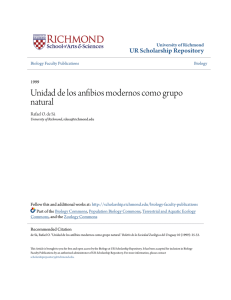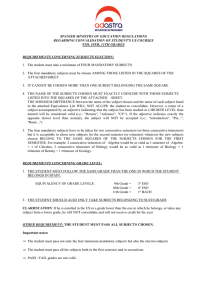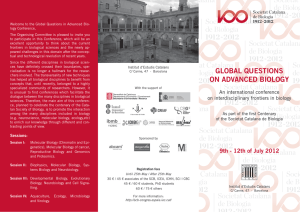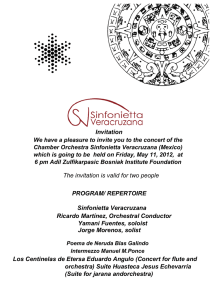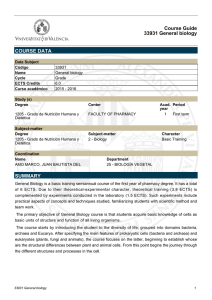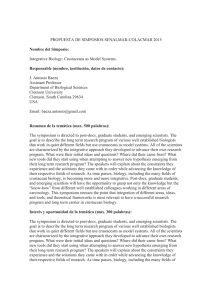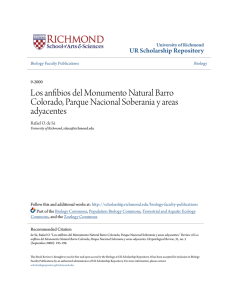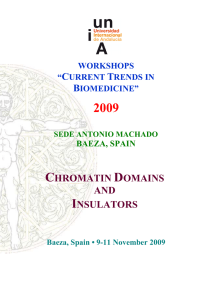BIOGRAPHICAL SKETCH Provide the following information for the
Anuncio
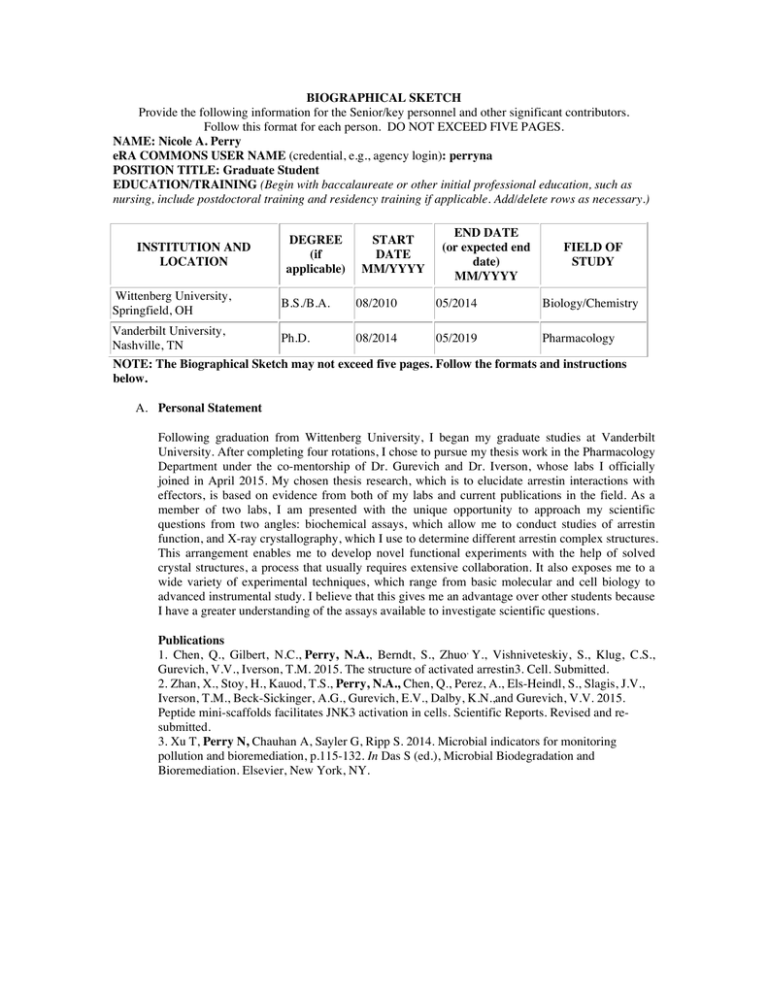
BIOGRAPHICAL SKETCH Provide the following information for the Senior/key personnel and other significant contributors. Follow this format for each person. DO NOT EXCEED FIVE PAGES. NAME: Nicole A. Perry eRA COMMONS USER NAME (credential, e.g., agency login): perryna POSITION TITLE: Graduate Student EDUCATION/TRAINING (Begin with baccalaureate or other initial professional education, such as nursing, include postdoctoral training and residency training if applicable. Add/delete rows as necessary.) INSTITUTION AND LOCATION DEGREE (if applicable) START DATE MM/YYYY END DATE (or expected end date) MM/YYYY FIELD OF STUDY Wittenberg University, Springfield, OH B.S./B.A. 08/2010 05/2014 Biology/Chemistry Vanderbilt University, Nashville, TN Ph.D. 08/2014 05/2019 Pharmacology NOTE: The Biographical Sketch may not exceed five pages. Follow the formats and instructions below. A. Personal Statement Following graduation from Wittenberg University, I began my graduate studies at Vanderbilt University. After completing four rotations, I chose to pursue my thesis work in the Pharmacology Department under the co-mentorship of Dr. Gurevich and Dr. Iverson, whose labs I officially joined in April 2015. My chosen thesis research, which is to elucidate arrestin interactions with effectors, is based on evidence from both of my labs and current publications in the field. As a member of two labs, I am presented with the unique opportunity to approach my scientific questions from two angles: biochemical assays, which allow me to conduct studies of arrestin function, and X-ray crystallography, which I use to determine different arrestin complex structures. This arrangement enables me to develop novel functional experiments with the help of solved crystal structures, a process that usually requires extensive collaboration. It also exposes me to a wide variety of experimental techniques, which range from basic molecular and cell biology to advanced instrumental study. I believe that this gives me an advantage over other students because I have a greater understanding of the assays available to investigate scientific questions. Publications 1. Chen, Q., Gilbert, N.C., Perry, N.A., Berndt, S., Zhuo, Y., Vishniveteskiy, S., Klug, C.S., Gurevich, V.V., Iverson, T.M. 2015. The structure of activated arrestin3. Cell. Submitted. 2. Zhan, X., Stoy, H., Kauod, T.S., Perry, N.A., Chen, Q., Perez, A., Els-Heindl, S., Slagis, J.V., Iverson, T.M., Beck-Sickinger, A.G., Gurevich, E.V., Dalby, K.N.,and Gurevich, V.V. 2015. Peptide mini-scaffolds facilitates JNK3 activation in cells. Scientific Reports. Revised and resubmitted. 3. Xu T, Perry N, Chauhan A, Sayler G, Ripp S. 2014. Microbial indicators for monitoring pollution and bioremediation, p.115-132. In Das S (ed.), Microbial Biodegradation and Bioremediation. Elsevier, New York, NY. B. Positions and Honors ACTIVITY/OCCUPATION START END DATE DATE MM/YYYY MM/YYYY Undergraduate Research 08/2011 12/2011 Microbiology Wittenberg University Dr. Jay Yoder Undergraduate Research 06/2012 12/2012 Organic Chemistry Wittenberg University Dr. Peter Hanson Undergraduate Research 01/2013 12/2013 Developmental Wittenberg University Biology Dr. Michelle McWhorter NSF REU 05/2013 08/2013 Microbial Ecology University of Tennessee Knoxville Dr. Gary Sayler/Dr. Steven Ripp Graduate Research 09/2014 10/2014 Microbiology Vanderbilt University Dr. Jim Cassat Graduate Research 11/2014 12/2014 Biological Sciences Vanderbilt University Dr. Jim Patton Graduate Research 01/2014 Present Pharmacology Vanderbilt University FIELD INSTITUTION/COMPANY SUPERVISOR/EMPLOYER Dr. Vsevolod Gurevich/Dr. Tina Iverson Academic and Professional Honors AWARDS 2015 2014 2013 2012 2011 2010 T32 Training Program in Pharmacological Science (training grant) Second place oral presentation at the Vanderbilt Pharmacology Retreat Alternate for Fulbright U.S. Student Program Research Grant in Argentina Mortar Board Fellow ($5,000 stipend) James T. Gregory Award for Outstanding Research Potential ($400 stipend) Summa Cum Laude Dean’s List Presidential Scholar (Top 13 of the class) NSF Grant REU at the University of Tennessee Knoxville for Microbial Ecology Recipient of the Outstanding Biology Student Award Dean’s List Omicron Delta Kappa Sophomore Involvement Award Dean’s List Alpha Lambda Delta Honor Society Dean’s List Kiwanis Club Scholarship ($4,000 stipend) Rotary Club Scholarship ($500 stipend) Wittenberg Scholar Award SOCIETY MEMBERSHIPS 2015 2013 2012 2010 American Association for the Advancement of Science (AAAS) Phi Beta Kappa (PBK) University Honors Program Departmental Honors in Biology Omicron Delta Kappa (ODK) Mortar Board Arrow and Mask chapter Beta Beta Beta Biological Honorary Society Alpha Lambda Delta Honor Society (ALD) C. Contributions to Science (for predoctoral students and more advanced candidates only; high school students, undergraduates, and postbaccalaureates should skip this section) 1. Chen, Q., Gilbert, N.C., Perry, N.A., Berndt, S., Zhuo, Y., Vishniveteskiy, S., Klug, C.S., Gurevich, V.V., Iverson, T.M. 2015. The structure of activated arrestin3. Cell. Submitted. Although my co-mentorship affords me the opportunity to learn a number of experimental techniques, I realize that good science cannot be accomplished without strong scientific collaborations. In May I was given the opportunity to visit Georgia Regents University to learn a new scientific technique for my lab, indirect bioluminescence resonance energy transfer (BRET), from a leading expert, Dr. Nevin Lambert. I worked with Dr. Lambert to modify the technique for my laboratory and was able to use this method to functionally test the predictions of the crystal structure of IP6-activated arrestin-3 that Dr. Chen had determined. 2. Perry, N.A., Gurevich, E.V., Stoy, H., Zhan, X., Chen, Q., Iverson, T.M. and Gurevich, V.V. N-terminal arrestin-3-derived peptide mini-scaffolds of the ASK1-MKK4/7-JNK3 cascade. In preparation. I am currently in the process of writing a manuscript for work I completed during my rotation in the Gurevich lab. MAP kinase c-Jun N-terminal kinase 3 (JNK3) is the final effector in the ASK1-MKK4/7-JNK3 cascade, which is implicated in cellular development and apoptosis. Earlier studies have shown that both arrestin-2 and arrestin-3 bind all three kinases of the cascade; however, only arrestin-3 facilitates the activation of JNK3. This suggests that in addition to binding all components of a MAPK cascade, individual kinases must also assemble in optimal relative orientations on arrestin to permit activation. It was shown by the Gurevich lab that the first 25 amino acid residues of arrestin-3 (T1A) bind the complete JNK3 cascade and facilitate JNK3 activation in cells. I used shorter T1A-derived peptides to isolate the arrestin-3 residues that interact with individual kinases of the ASK1MKK4/7-JNK3 cascade, and showed that a 16-residue peptide binds all kinases and facilitates JNK3 activation in cells. 3. Zhan, X., Stoy, H., Kauod, T.S., Perry, N.A., Chen, Q., Perez, A., Els-Heindl, S., Slagis, J.V., Iverson, T.M., Beck-Sickinger, A.G., Gurevich, E.V., Dalby, K.N.,and Gurevich, V.V. 2015. Peptide mini-scaffolds facilitates JNK3 activation in cells. Scientific Reports. Revised and re-submitted. My work with the arrestin-3-derived peptides (see above) also afforded me the opportunity to contribute to the original T1A paper. I used a series of pull-down assays to assess binding of the kinases MKK4 and MKK7 to wild-type arrestin-3, T1A, and B1A, arrestin-2-derived peptide homologous to T1A. I also contributed to the writing process of the manuscript as well as developed figures for the paper. 4. Prokop, S., Vishnivetskiy, S.A., Perry, N.A., Hunyady, L., Iverson, T.M., and Gurevich, V.V. Differential manipulation of basal and agonist-induced arrestin-3 binding to GPCRs. Journal of Biological Chemistry. Submitted. Even though I am still at an early stage in my career, I consider training the next generation of scientists very important. This summer in Dr. Gurevich’s lab I supervised a medical student from Hungary, Susanne Prokop, who worked with me on a new assay for receptor specificity. This paper is the result of that mentorship, and is the first to use the new BRET technique that I learned and optimized for our laboratory. 5. Xu T, Perry N, Chauhan A, Sayler G, Ripp S. 2014. Microbial indicators for monitoring pollution and bioremediation, p.115-132. In Das S (ed.), Microbial Biodegradation and Bioremediation. Elsevier, New York, NY. The summer before my senior year I was admitted into a competitive National Science Foundation funded Research Experience for Undergraduates (REU) program sponsored by the University of Tennessee Knoxville. I conducted research under Dr. Gary Sayler that focused on how temperature affects cold shock protein A (cspA) gene expression in the psychrotroph Pseudomonas fluorescens HK44, which was genetically engineered by the lab to bioluminesce upon exposure to naphthalene and can be used to monitor naphthalene biodegradation in the soil. An enhanced understanding of regulatory controls for the cspA genes allows for better risk assessment of introducing P. fluorescens HK44 into the environment. I found that shifts in temperature from 4°C to 28°C had an effect on the log phase gene expression of cspA1168, which indicated that the organism’s optimal growth occurred at warmer temperatures. Throughout my research, I became acquainted with a new, more sophisticated array of instrumentation and techniques than I had previously known. I was able to publish the above review during my time in the laboratory as well as present a comprehensive honors thesis based on my work. D. Scholastic Performance S: C- through A+ inclusive YEAR SCIENCE COURSE TITLE GRADE YEAR OTHER COURSE TITLE GRADE 2010 Concepts of Biology I A 2010 Introduction to Expository Writing A 2010 Concepts of Biology Lab S 2010 Artistic Excursions A+ 2010 Models of Chemical Systems A 2010 Applied Viola A 2010 Calculus I S 2010 Chamber Orchestra S 2010 Topics in Biology S 2010 Themes-Traditions Literature S 2011 Concepts of Biology II A 2011 El Arte de la Traduccion A 2011 Concepts of Biology Lab S 2011 Social Dance S 2011 Chemical Structure and Analysis A 2011 Applied Viola A 2011 Calculus II A 2011 Community Service S 2011 Developmental Biology A+ 2011 Serving and Support Child A 2011 Biological Literacy A 2011 Introduction to Psychology A 2011 Organic Chemistry I A 2011 Race, Gender, Science and Med A 2012 Interm. Organic Chemistry A- 2011 Chamber Orchestra A 2012 Mechanics and Waves A 2011 Applied Viola A- 2012 Analytical Chemistry A- 2012 Understanding Music A 2012 Chemistry, Junior Seminar A 2012 Chamber Ensemble A 2012 Human Anatomy and Phys. A 2012 Chamber Orchestra A 2012 Introductory Electromagnetism A 2012 Japanese Women’s Literature A 2012 Independent Research A 2012 Applied Viola A 2013 Chemistry, Junior Seminar A 2012 Chamber Orchestra A 2013 Microbiology A 2013 Weight Training S YEAR SCIENCE COURSE TITLE GRADE YEAR OTHER COURSE TITLE GRADE 2013 Directed Research S 2013 Elementary Music Theory A 2013 Chemistry, Senior Seminar A 2013 Chamber Orchestra A 2013 Thermodynamics and Kinetics A- 2013 Sexuality/Athleticism Ancient Greek A+ 2013 Honors Thesis/Project A 2013 Applied Viola A 2013 Principles of Biochemistry A 2013 Beatles and Their Predecessors A 2014 Senior Capstone A+ 2013 Applied Viola A 2014 Statistics A 2013 Chamber Orchestra A 2014 Chemistry, Senior Seminar A 2014 History of Western Music A 2014 Bioregulation I A 2014 El Mundo Fisico A 2014 Non-candidate Research S 2014 Applied Viola A 2015 Introduction to Modern Bio Microscopy A 2014 Chamber Orchestra A 2015 Special Topics in Cell Biology A 2015 Bioregulation II A- 2015 Non-candidate Research S 2015 Receptor Theory Cell Surface A 2015 Pharm 320A A
